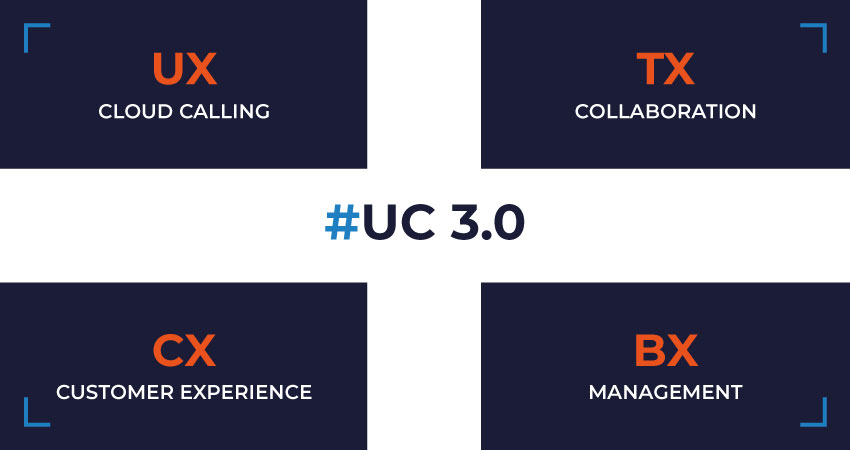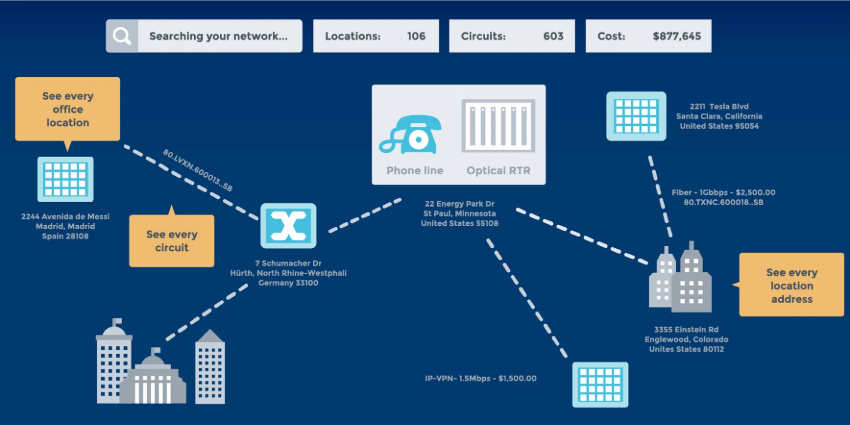UCaaS has become more of the most essential mandatory investments of any business in the post-pandemic landscape. Driven by a rising demand for more flexible, scalable, and agile environment for collaboration and communication, companies have begun to build their entire workflow around Unified Communications as a Service.
Estimates now predict around 70% of organisations will be using UCaaS by 2023, to some degree.
As the shift to cloud communications continues to soar, our definition of “Unified Communications” is evolving too. Increasingly, we’re seeing new focus on concepts like employee wellbeing, employee experience, personalisation and workflow automation.
What is UC 3.0? Unified Communications in 2022
In May 2019, before the pandemic began, we discussed the impending arrival of a new kind of Unified Communications – one defined by experience. In this definition, we looked at the idea of Unified Communications becoming a cloud-first, disruptive environment, capable of enabling agility and efficiency for businesses of any sizes.
Clearly, this vision of UC 3.0 has grown increasingly clear in recent years, particularly with the onset of the pandemic. The rise of new flexible working strategies and “hybrid work” has prompted an increased focus on the use of new innovative apps, aligned tools, and integrations within a flexible UC ecosystem. UCaaS, aligned with the team collaboration tool, is even becoming the central “hub” of the workplace for many companies.
In 2019, we defined four pillars of UC 3.0 which remain relevant today:
- User Experience: User experience in the new UC environment focuses on one-to-one communication within daily work life. Users need to be able to connect from anywhere, on any device, powering hybrid working and frontline work for organisations small and large. The user experience needs to flow, integrating mission-critical business apps and workflows that drive productivity and efficiency regardless of location.
- Team Experience: Perhaps one of the most significant aspects of UC 3.0 to evolve in recent years, team experience now involves ensuring staff members can remain aligned on the same goals from multiple locations around the world. Hybrid and flexible work means we need to work harder to bring people together in immersive ways and maintain company culture. It’s also important for companies to ensure they’re improving meeting equity and inclusivity when teams are distributed.
- Customer Experience: CX or customer experience continues to be the primary focus point of many businesses in an environment where consumers are growing increasingly demanding. Since the pandemic, improving customer experience has started to involve a greater focus on digital communications, omnichannel interactions, and self-service.
- Business Experience: This refers to the way companies ensure the entire business thrives in a new post-pandemic landscape. The business experience today is likely to be defined by everything from the use of specific endpoints to align teams, to the way we manage internet connections and security in a hybrid space. The ability to manage and deliver tools is an element of business experience too. In a world of hybrid work, companies need UC tools they can easily provision, patch, and manage from a distance.
The UC 3.0 Layers Crucial to 2022 and Beyond
The evolution of the workplace and the new challenges prompted by the pandemic has made a huge difference to the way we choose and implement UCaaS solutions. Investing in UC 3.0 now means considering your communication needs from a range of different perspectives. Although the exact requirements of your company will depend on a range of factors, common layers will include:
- Cloud Calling: Cloud calling is no longer an option in 2022 and the post-pandemic world. We need a cloud-based communications environment available that ensures reliability and continuity for employees that are working from anywhere, and everywhere. Cloud solutions allow teams to stay productive in any environment, without the restrictions of the standard PSTN.
- Endpoints: Endpoints will always be a critical part of the UC stack. The tools we need today have evolved somewhat from the technologies most companies were investing in a couple of years ago. Softphone apps and phones are still a crucial consideration for many brands. However, there’s also an increased focus on premium quality headsets, speakerphones, and of course, webcams, for video calls and meetings. Plug-and-play simplicity to enable hybrid workers is crucial in this new environment.
- Meetings: While meetings have always been a critical part of the UC environment, they’ve never been more essential than they are in the post-pandemic landscape. Video conferencing has evolved into a daily practice for most employees. This means companies need more flexible environments for ad-hoc meetings and regular conversations. Collaboration bars, room kits, and ceiling microphones have all become increasingly common as businesses tool up for hybrid work.
- Messaging and Team Channels: Messaging, as one of the most flexible forms of collaborative communication, provides a quick and easy way to keep teams connected in a hybrid space. Team channels allow companies to organize their staff members into groups based on shared topics of interest and focus areas.
- Workflow Integrations: As we discover new forms of making the workplace more efficient, workflow integrations are becoming increasingly common. APIs, bots, and apps allow individual users to automate and enhance different parts of their workflow to improve efficiency. Low code and no-code solutions create environments where anyone can build their own automations with little or no coding skills.
- Contact Centre: Still an essential part of any company’s business operations, customer experience is quickly making its way into the UC environment. We’re seeing CCaaS and UCaaS become increasingly aligned, with CRM integrations, customer engagement insights and new tools for conversational analytics and reporting.
- UC Service Management: To keep everything running smoothly from a Business Experience perspective, companies need a more aligned environment for provisioning, deployment, and end-user support. UC Service management tools assist with everything from diagnostics and adoption to trouble-shooting solutions with self-healing technology.
Unlocking the New UC 3.0
Clearly, we’ve come a long way in a very short time with the transition to the future of Unified Communications. Many of the points we discussed a couple of years ago are still relevant today, but we now have a much clearer view of what the future of UC should be like for the majority of enterprises.
The key thing to remember for any company investing in UC 3.0 today, is that there’s no one-size-fits-all solution for success. Personalising the experience for your specific users, teams and customers will be critical to your success.








